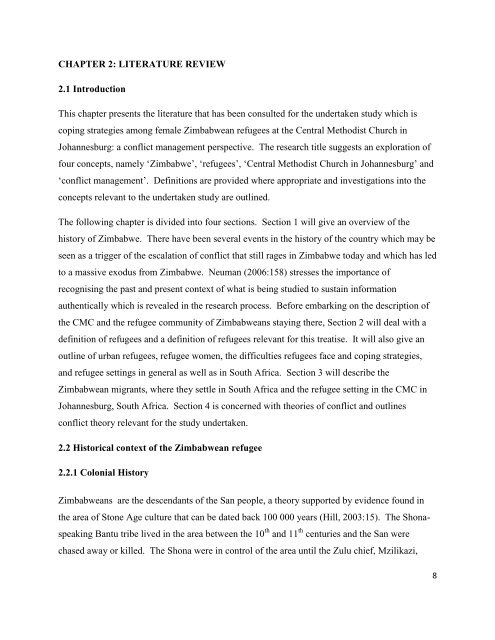Guro Lauvland Bjorknes.pdf - NMMU
Guro Lauvland Bjorknes.pdf - NMMU
Guro Lauvland Bjorknes.pdf - NMMU
You also want an ePaper? Increase the reach of your titles
YUMPU automatically turns print PDFs into web optimized ePapers that Google loves.
CHAPTER 2: LITERATURE REVIEW<br />
2.1 Introduction<br />
This chapter presents the literature that has been consulted for the undertaken study which is<br />
coping strategies among female Zimbabwean refugees at the Central Methodist Church in<br />
Johannesburg: a conflict management perspective. The research title suggests an exploration of<br />
four concepts, namely „Zimbabwe‟, „refugees‟, „Central Methodist Church in Johannesburg‟ and<br />
„conflict management‟. Definitions are provided where appropriate and investigations into the<br />
concepts relevant to the undertaken study are outlined.<br />
The following chapter is divided into four sections. Section 1 will give an overview of the<br />
history of Zimbabwe. There have been several events in the history of the country which may be<br />
seen as a trigger of the escalation of conflict that still rages in Zimbabwe today and which has led<br />
to a massive exodus from Zimbabwe. Neuman (2006:158) stresses the importance of<br />
recognising the past and present context of what is being studied to sustain information<br />
authentically which is revealed in the research process. Before embarking on the description of<br />
the CMC and the refugee community of Zimbabweans staying there, Section 2 will deal with a<br />
definition of refugees and a definition of refugees relevant for this treatise. It will also give an<br />
outline of urban refugees, refugee women, the difficulties refugees face and coping strategies,<br />
and refugee settings in general as well as in South Africa. Section 3 will describe the<br />
Zimbabwean migrants, where they settle in South Africa and the refugee setting in the CMC in<br />
Johannesburg, South Africa. Section 4 is concerned with theories of conflict and outlines<br />
conflict theory relevant for the study undertaken.<br />
2.2 Historical context of the Zimbabwean refugee<br />
2.2.1 Colonial History<br />
Zimbabweans are the descendants of the San people, a theory supported by evidence found in<br />
the area of Stone Age culture that can be dated back 100 000 years (Hill, 2003:15). The Shona-<br />
speaking Bantu tribe lived in the area between the 10 th and 11 th centuries and the San were<br />
chased away or killed. The Shona were in control of the area until the Zulu chief, Mzilikazi,<br />
8
















